Reflective Essay: Cultural Intelligence and the Shaping of Identity
VerifiedAdded on 2022/11/28
|5
|1236
|312
Essay
AI Summary
This reflective essay delves into the multifaceted concept of cultural intelligence (CQ) and its profound impact on workplace interactions. The author examines three core aspects of identity—personal, social relational, and communal—to illustrate how they collectively shape an individual's cultural identity. The essay highlights the increasing significance of CQ, which goes beyond IQ and EQ, in navigating diverse cultural landscapes within organizations. It defines personal identity as an evolving self-concept, social relational identity as the connection with society, and communal identity as the group's shared self-perception. The essay explores how these identities influence individual interactions, role-based relationships, and overall workplace dynamics, emphasizing the importance of recognizing and understanding cultural differences for effective collaboration and success. The essay concludes by underscoring the critical role of these identities in fostering a cohesive and culturally intelligent environment within the modern workplace.
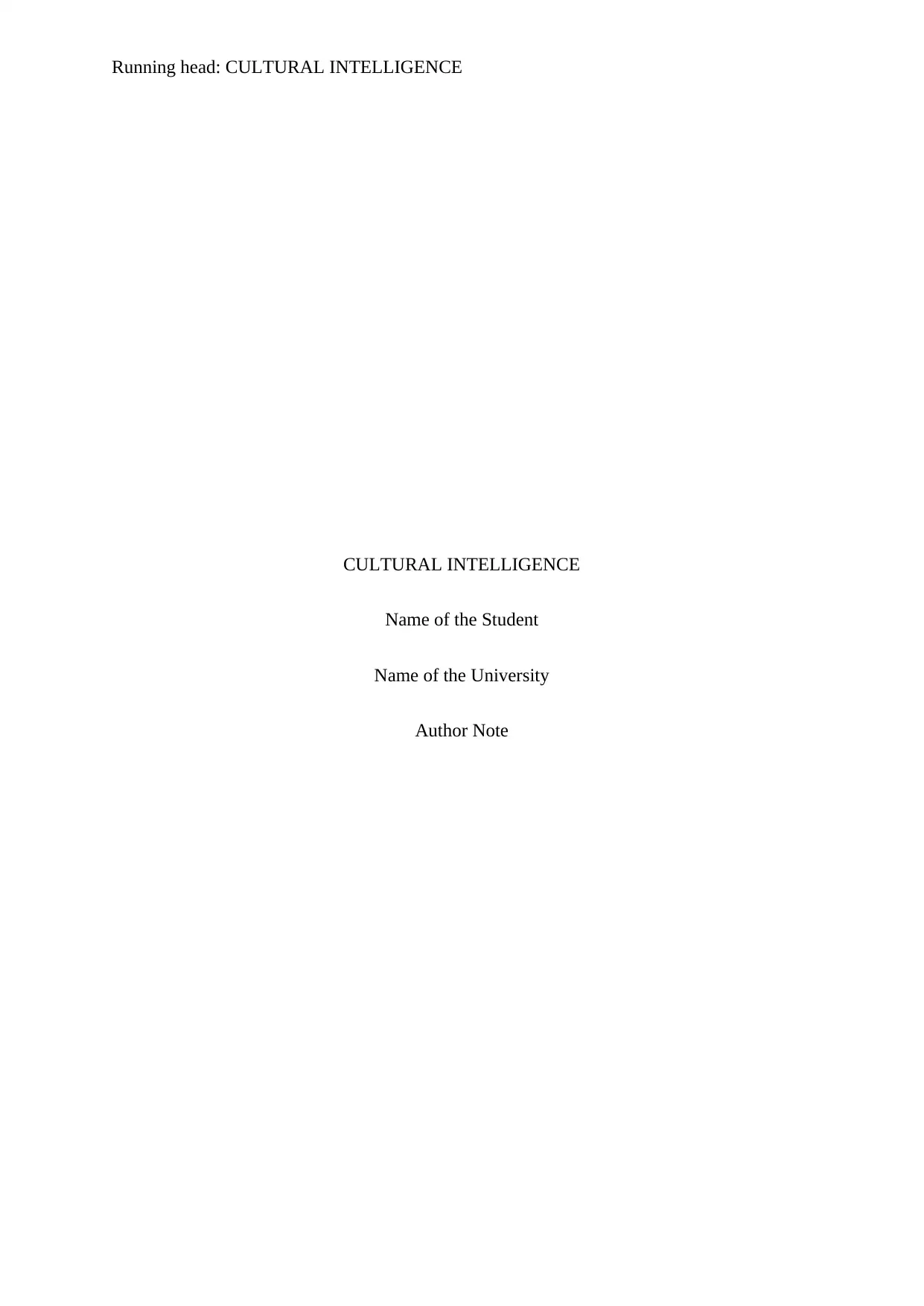
Running head: CULTURAL INTELLIGENCE
CULTURAL INTELLIGENCE
Name of the Student
Name of the University
Author Note
CULTURAL INTELLIGENCE
Name of the Student
Name of the University
Author Note
Paraphrase This Document
Need a fresh take? Get an instant paraphrase of this document with our AI Paraphraser
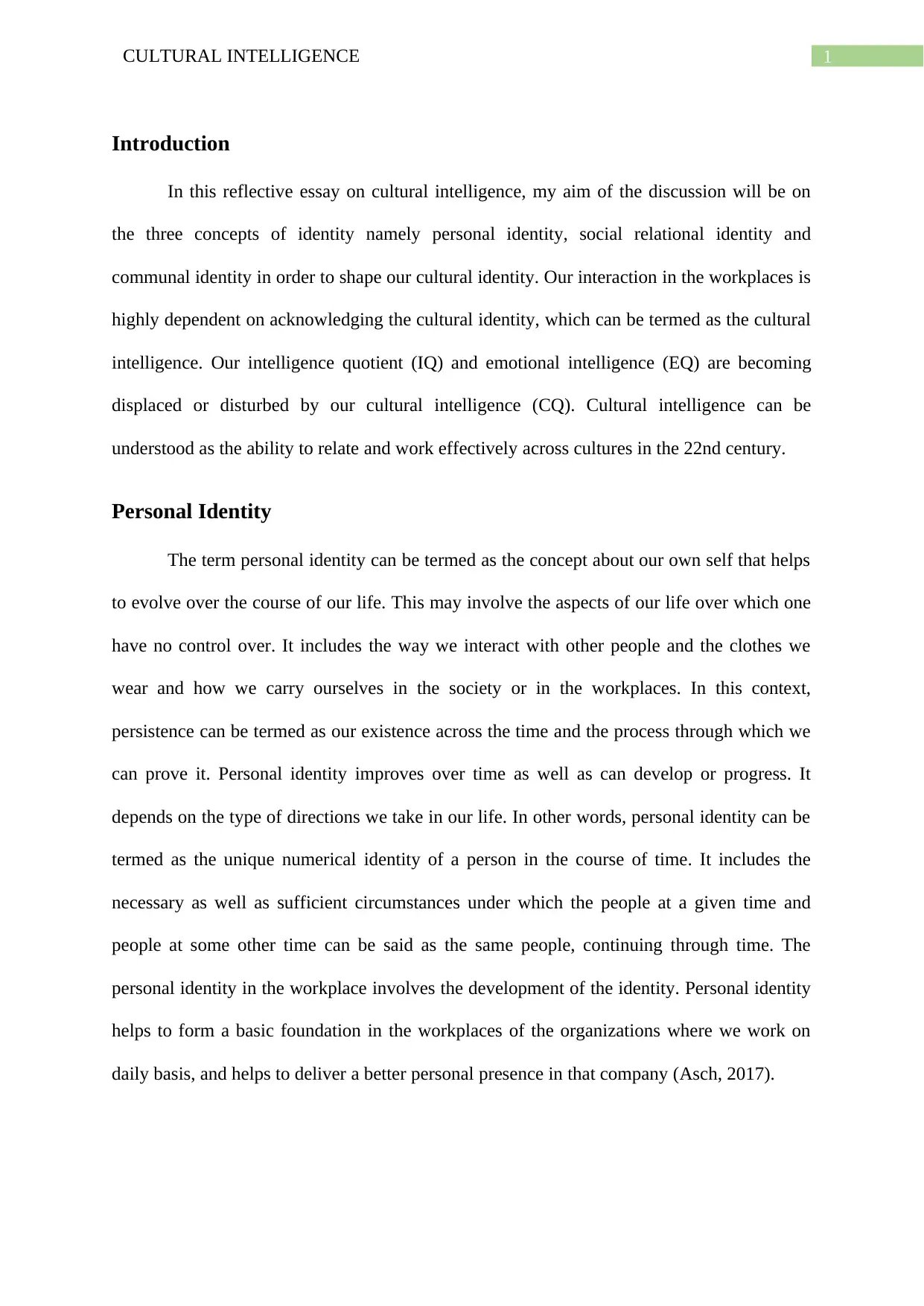
1CULTURAL INTELLIGENCE
Introduction
In this reflective essay on cultural intelligence, my aim of the discussion will be on
the three concepts of identity namely personal identity, social relational identity and
communal identity in order to shape our cultural identity. Our interaction in the workplaces is
highly dependent on acknowledging the cultural identity, which can be termed as the cultural
intelligence. Our intelligence quotient (IQ) and emotional intelligence (EQ) are becoming
displaced or disturbed by our cultural intelligence (CQ). Cultural intelligence can be
understood as the ability to relate and work effectively across cultures in the 22nd century.
Personal Identity
The term personal identity can be termed as the concept about our own self that helps
to evolve over the course of our life. This may involve the aspects of our life over which one
have no control over. It includes the way we interact with other people and the clothes we
wear and how we carry ourselves in the society or in the workplaces. In this context,
persistence can be termed as our existence across the time and the process through which we
can prove it. Personal identity improves over time as well as can develop or progress. It
depends on the type of directions we take in our life. In other words, personal identity can be
termed as the unique numerical identity of a person in the course of time. It includes the
necessary as well as sufficient circumstances under which the people at a given time and
people at some other time can be said as the same people, continuing through time. The
personal identity in the workplace involves the development of the identity. Personal identity
helps to form a basic foundation in the workplaces of the organizations where we work on
daily basis, and helps to deliver a better personal presence in that company (Asch, 2017).
Introduction
In this reflective essay on cultural intelligence, my aim of the discussion will be on
the three concepts of identity namely personal identity, social relational identity and
communal identity in order to shape our cultural identity. Our interaction in the workplaces is
highly dependent on acknowledging the cultural identity, which can be termed as the cultural
intelligence. Our intelligence quotient (IQ) and emotional intelligence (EQ) are becoming
displaced or disturbed by our cultural intelligence (CQ). Cultural intelligence can be
understood as the ability to relate and work effectively across cultures in the 22nd century.
Personal Identity
The term personal identity can be termed as the concept about our own self that helps
to evolve over the course of our life. This may involve the aspects of our life over which one
have no control over. It includes the way we interact with other people and the clothes we
wear and how we carry ourselves in the society or in the workplaces. In this context,
persistence can be termed as our existence across the time and the process through which we
can prove it. Personal identity improves over time as well as can develop or progress. It
depends on the type of directions we take in our life. In other words, personal identity can be
termed as the unique numerical identity of a person in the course of time. It includes the
necessary as well as sufficient circumstances under which the people at a given time and
people at some other time can be said as the same people, continuing through time. The
personal identity in the workplace involves the development of the identity. Personal identity
helps to form a basic foundation in the workplaces of the organizations where we work on
daily basis, and helps to deliver a better personal presence in that company (Asch, 2017).
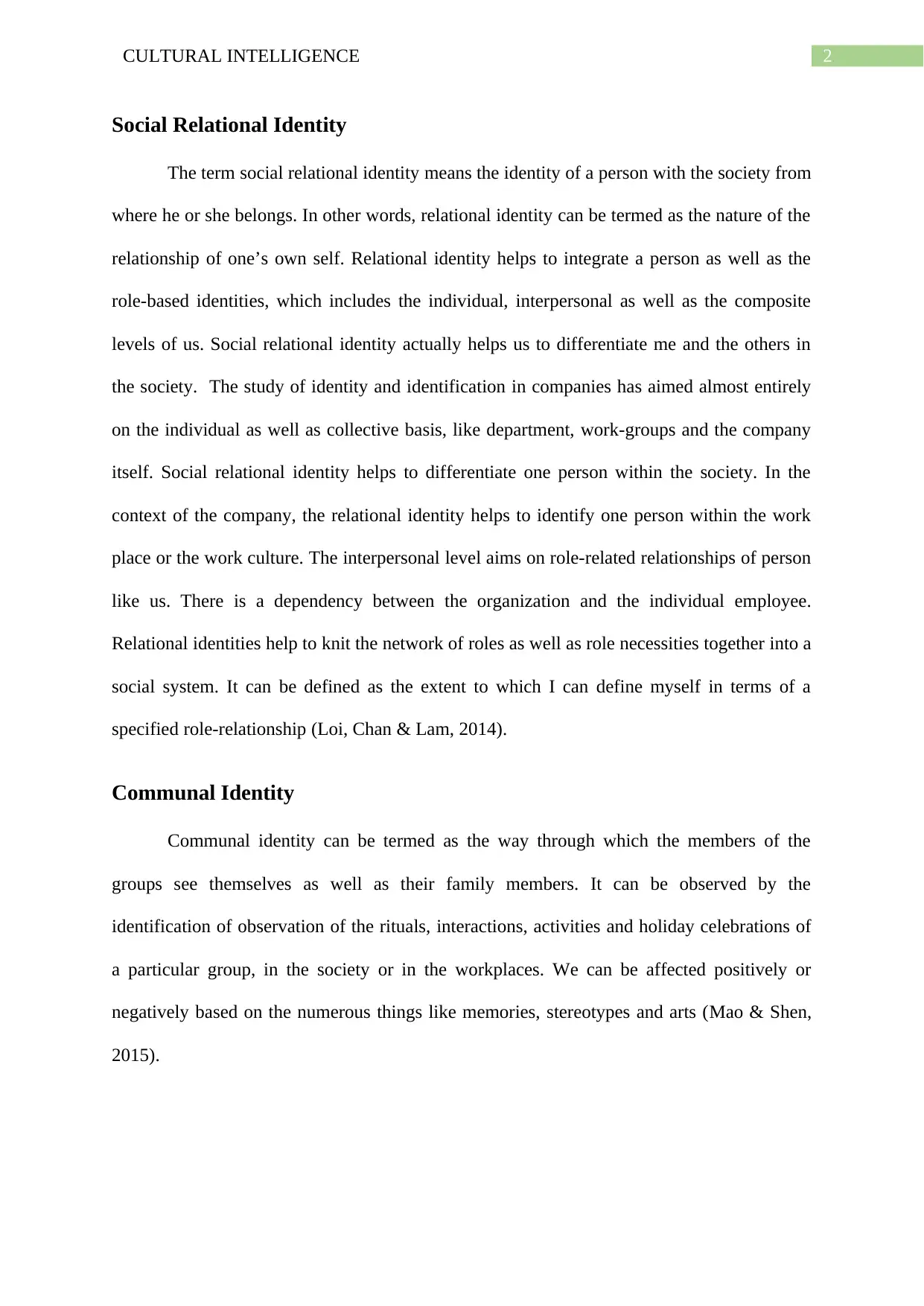
2CULTURAL INTELLIGENCE
Social Relational Identity
The term social relational identity means the identity of a person with the society from
where he or she belongs. In other words, relational identity can be termed as the nature of the
relationship of one’s own self. Relational identity helps to integrate a person as well as the
role-based identities, which includes the individual, interpersonal as well as the composite
levels of us. Social relational identity actually helps us to differentiate me and the others in
the society. The study of identity and identification in companies has aimed almost entirely
on the individual as well as collective basis, like department, work-groups and the company
itself. Social relational identity helps to differentiate one person within the society. In the
context of the company, the relational identity helps to identify one person within the work
place or the work culture. The interpersonal level aims on role-related relationships of person
like us. There is a dependency between the organization and the individual employee.
Relational identities help to knit the network of roles as well as role necessities together into a
social system. It can be defined as the extent to which I can define myself in terms of a
specified role-relationship (Loi, Chan & Lam, 2014).
Communal Identity
Communal identity can be termed as the way through which the members of the
groups see themselves as well as their family members. It can be observed by the
identification of observation of the rituals, interactions, activities and holiday celebrations of
a particular group, in the society or in the workplaces. We can be affected positively or
negatively based on the numerous things like memories, stereotypes and arts (Mao & Shen,
2015).
Social Relational Identity
The term social relational identity means the identity of a person with the society from
where he or she belongs. In other words, relational identity can be termed as the nature of the
relationship of one’s own self. Relational identity helps to integrate a person as well as the
role-based identities, which includes the individual, interpersonal as well as the composite
levels of us. Social relational identity actually helps us to differentiate me and the others in
the society. The study of identity and identification in companies has aimed almost entirely
on the individual as well as collective basis, like department, work-groups and the company
itself. Social relational identity helps to differentiate one person within the society. In the
context of the company, the relational identity helps to identify one person within the work
place or the work culture. The interpersonal level aims on role-related relationships of person
like us. There is a dependency between the organization and the individual employee.
Relational identities help to knit the network of roles as well as role necessities together into a
social system. It can be defined as the extent to which I can define myself in terms of a
specified role-relationship (Loi, Chan & Lam, 2014).
Communal Identity
Communal identity can be termed as the way through which the members of the
groups see themselves as well as their family members. It can be observed by the
identification of observation of the rituals, interactions, activities and holiday celebrations of
a particular group, in the society or in the workplaces. We can be affected positively or
negatively based on the numerous things like memories, stereotypes and arts (Mao & Shen,
2015).
⊘ This is a preview!⊘
Do you want full access?
Subscribe today to unlock all pages.

Trusted by 1+ million students worldwide
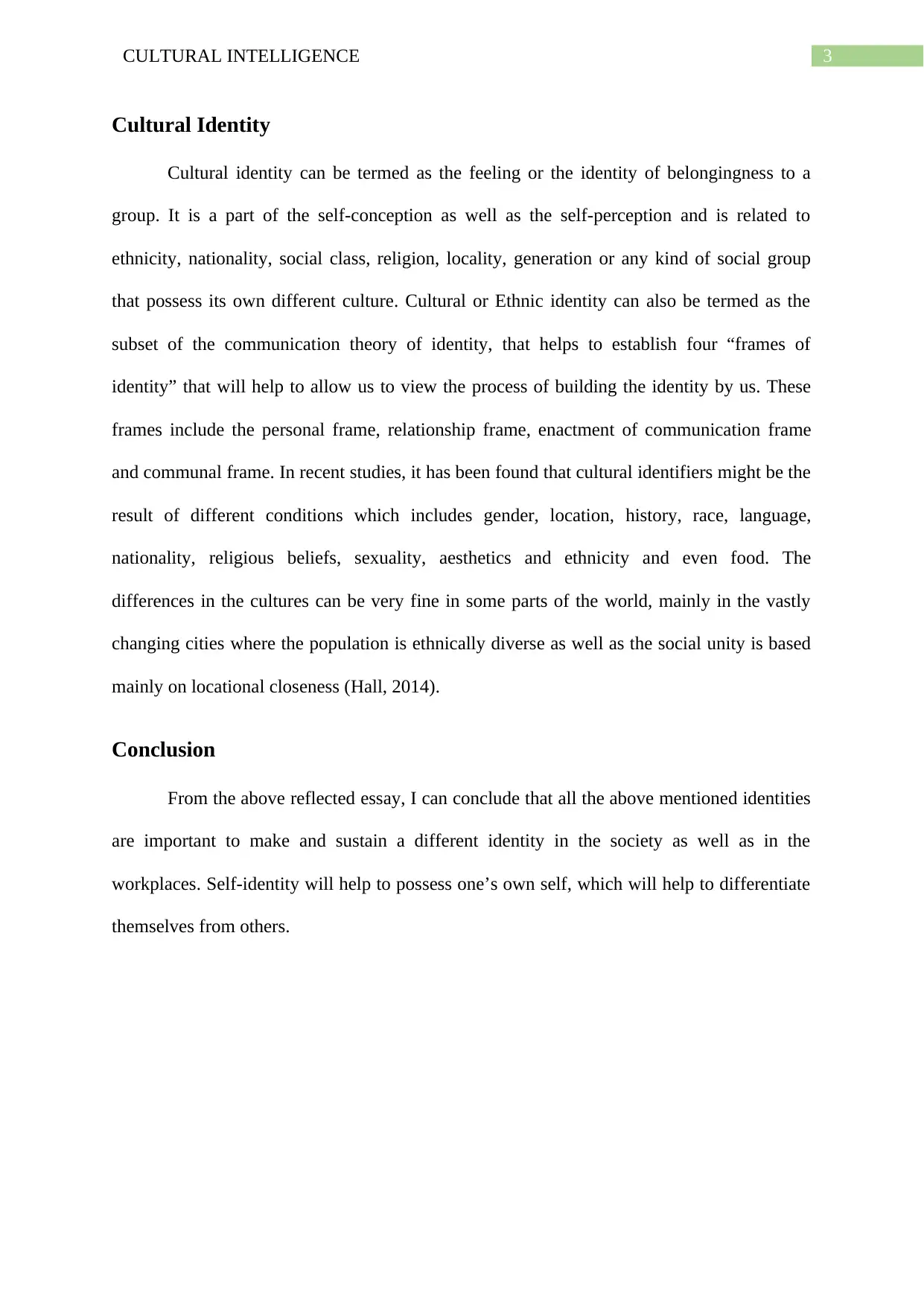
3CULTURAL INTELLIGENCE
Cultural Identity
Cultural identity can be termed as the feeling or the identity of belongingness to a
group. It is a part of the self-conception as well as the self-perception and is related to
ethnicity, nationality, social class, religion, locality, generation or any kind of social group
that possess its own different culture. Cultural or Ethnic identity can also be termed as the
subset of the communication theory of identity, that helps to establish four “frames of
identity” that will help to allow us to view the process of building the identity by us. These
frames include the personal frame, relationship frame, enactment of communication frame
and communal frame. In recent studies, it has been found that cultural identifiers might be the
result of different conditions which includes gender, location, history, race, language,
nationality, religious beliefs, sexuality, aesthetics and ethnicity and even food. The
differences in the cultures can be very fine in some parts of the world, mainly in the vastly
changing cities where the population is ethnically diverse as well as the social unity is based
mainly on locational closeness (Hall, 2014).
Conclusion
From the above reflected essay, I can conclude that all the above mentioned identities
are important to make and sustain a different identity in the society as well as in the
workplaces. Self-identity will help to possess one’s own self, which will help to differentiate
themselves from others.
Cultural Identity
Cultural identity can be termed as the feeling or the identity of belongingness to a
group. It is a part of the self-conception as well as the self-perception and is related to
ethnicity, nationality, social class, religion, locality, generation or any kind of social group
that possess its own different culture. Cultural or Ethnic identity can also be termed as the
subset of the communication theory of identity, that helps to establish four “frames of
identity” that will help to allow us to view the process of building the identity by us. These
frames include the personal frame, relationship frame, enactment of communication frame
and communal frame. In recent studies, it has been found that cultural identifiers might be the
result of different conditions which includes gender, location, history, race, language,
nationality, religious beliefs, sexuality, aesthetics and ethnicity and even food. The
differences in the cultures can be very fine in some parts of the world, mainly in the vastly
changing cities where the population is ethnically diverse as well as the social unity is based
mainly on locational closeness (Hall, 2014).
Conclusion
From the above reflected essay, I can conclude that all the above mentioned identities
are important to make and sustain a different identity in the society as well as in the
workplaces. Self-identity will help to possess one’s own self, which will help to differentiate
themselves from others.
Paraphrase This Document
Need a fresh take? Get an instant paraphrase of this document with our AI Paraphraser
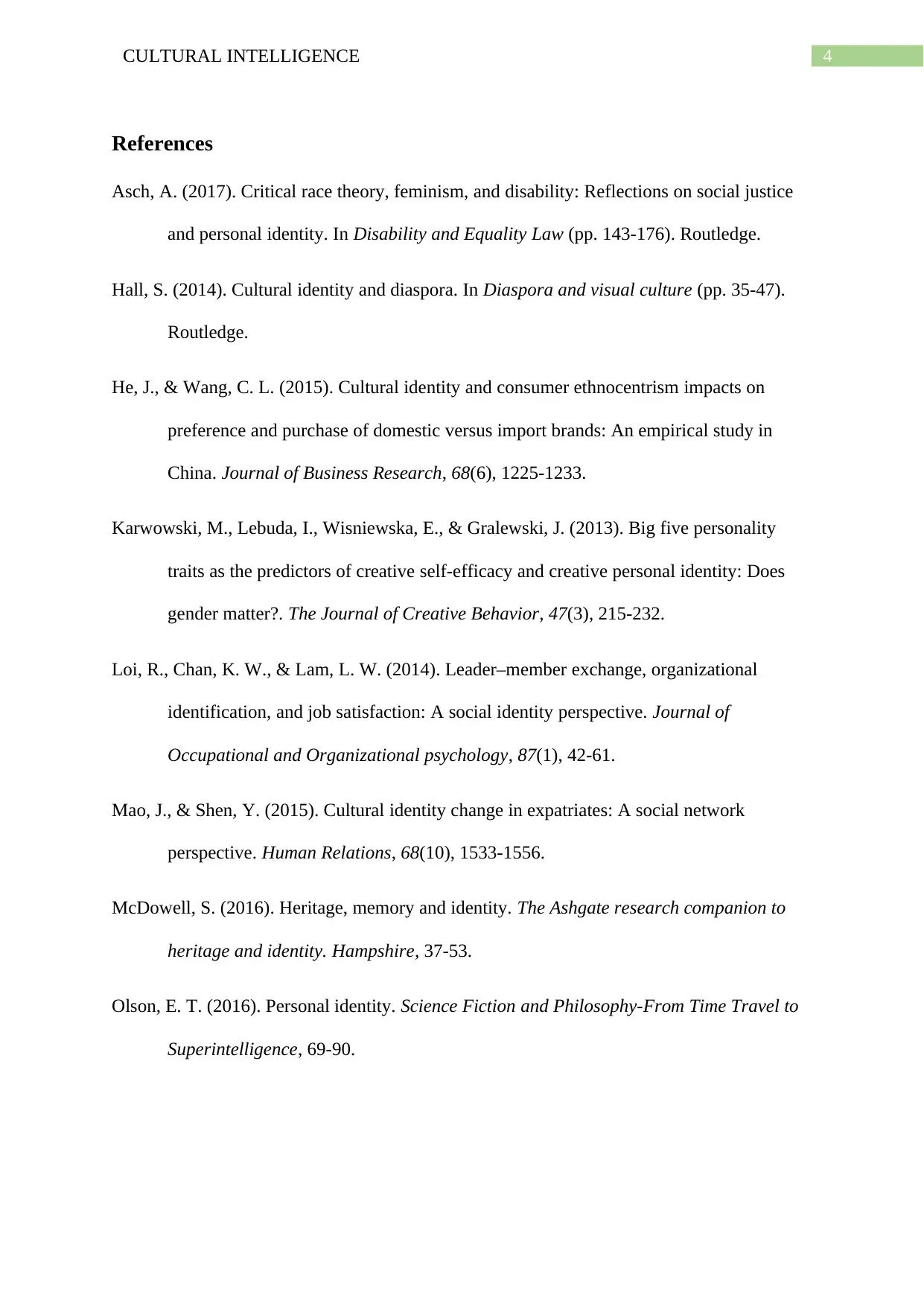
4CULTURAL INTELLIGENCE
References
Asch, A. (2017). Critical race theory, feminism, and disability: Reflections on social justice
and personal identity. In Disability and Equality Law (pp. 143-176). Routledge.
Hall, S. (2014). Cultural identity and diaspora. In Diaspora and visual culture (pp. 35-47).
Routledge.
He, J., & Wang, C. L. (2015). Cultural identity and consumer ethnocentrism impacts on
preference and purchase of domestic versus import brands: An empirical study in
China. Journal of Business Research, 68(6), 1225-1233.
Karwowski, M., Lebuda, I., Wisniewska, E., & Gralewski, J. (2013). Big five personality
traits as the predictors of creative self‐efficacy and creative personal identity: Does
gender matter?. The Journal of Creative Behavior, 47(3), 215-232.
Loi, R., Chan, K. W., & Lam, L. W. (2014). Leader–member exchange, organizational
identification, and job satisfaction: A social identity perspective. Journal of
Occupational and Organizational psychology, 87(1), 42-61.
Mao, J., & Shen, Y. (2015). Cultural identity change in expatriates: A social network
perspective. Human Relations, 68(10), 1533-1556.
McDowell, S. (2016). Heritage, memory and identity. The Ashgate research companion to
heritage and identity. Hampshire, 37-53.
Olson, E. T. (2016). Personal identity. Science Fiction and Philosophy-From Time Travel to
Superintelligence, 69-90.
References
Asch, A. (2017). Critical race theory, feminism, and disability: Reflections on social justice
and personal identity. In Disability and Equality Law (pp. 143-176). Routledge.
Hall, S. (2014). Cultural identity and diaspora. In Diaspora and visual culture (pp. 35-47).
Routledge.
He, J., & Wang, C. L. (2015). Cultural identity and consumer ethnocentrism impacts on
preference and purchase of domestic versus import brands: An empirical study in
China. Journal of Business Research, 68(6), 1225-1233.
Karwowski, M., Lebuda, I., Wisniewska, E., & Gralewski, J. (2013). Big five personality
traits as the predictors of creative self‐efficacy and creative personal identity: Does
gender matter?. The Journal of Creative Behavior, 47(3), 215-232.
Loi, R., Chan, K. W., & Lam, L. W. (2014). Leader–member exchange, organizational
identification, and job satisfaction: A social identity perspective. Journal of
Occupational and Organizational psychology, 87(1), 42-61.
Mao, J., & Shen, Y. (2015). Cultural identity change in expatriates: A social network
perspective. Human Relations, 68(10), 1533-1556.
McDowell, S. (2016). Heritage, memory and identity. The Ashgate research companion to
heritage and identity. Hampshire, 37-53.
Olson, E. T. (2016). Personal identity. Science Fiction and Philosophy-From Time Travel to
Superintelligence, 69-90.
1 out of 5
Related Documents
Your All-in-One AI-Powered Toolkit for Academic Success.
+13062052269
info@desklib.com
Available 24*7 on WhatsApp / Email
![[object Object]](/_next/static/media/star-bottom.7253800d.svg)
Unlock your academic potential
Copyright © 2020–2025 A2Z Services. All Rights Reserved. Developed and managed by ZUCOL.





